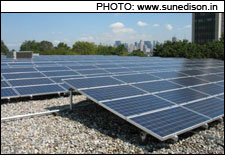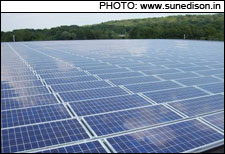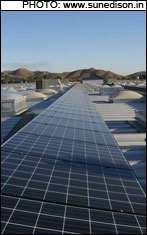 Pashupathy Shankar Gopalan, Managing Director, South Asia & Sub-Saharan Africa Operations, SunEdison
Pashupathy Shankar Gopalan, Managing Director, South Asia & Sub-Saharan Africa Operations, SunEdison
Pashupathy Gopalan holds a B-Tech in Metallurgical Engineering from IIT-BHU and M.S. in Materials Science and Engineering from Arizona State University and an MBA from Stanford University, USA. Gopalan, who is responsible for building SunEdison’s solar energy services business in India, SAARC, Southeast Asia, and Sub-Saharan Africa, takes Pradip Bhattacharya on a long tour of the Indian renewable energy sector.
How do you see growth in the Indian renewable energy sector despite the weak economic scenario?
Renewable is here to stay and grow. The visionary renewable energy policies formulated by the Ministry of New and Renewable Energy and various states have created the right platform for deployment of renewable energy sources. We easily expect that about 1,500 MW of solar power will be added to the renewable energy portfolio of the country in next one-and-a-half to two years.
Rising coal and diesel prices will only lead to an early and faster adoption of solar power, as solar is on its path to achieve grid parity in the next few years.
Diesel price hikes are a big challenge for industrial and commercial customers who rely heavily on diesel-based generators to augment grid supplied electricity to battle outages. At the current diesel prices, cost of per unit electricity generated by diesel is around 16-17/kWh, depending on the generator efficiency. Add to this are the procurement, transportation and storage costs, not to mention the added regular hassle.
Solar power is a great alternative for all industries which heavily depend on diesel today. At 7- 8/kWh, solar power is available at almost half the price of diesel based power today. We see great opportunity in commercial and industrial markets across India as solar is not only a clean source with almost negligible maintenance requirements from the owner; it is also affordable and leads to cost savings.
 Do you think the government will achieve its goal of turning India into a solar power nation?
Do you think the government will achieve its goal of turning India into a solar power nation?
Definitely, with one of the best insolation in the world, 300+ sunny days and cost of deployment rapidly coming down, solar is on its way to becoming the key source of energy in India. From August 2011 to July 2012, India went from 2.5 MW of grid connected solar PV to over 1,000 MW.
With policies having shown the way, this number will only increase steeply in the coming years. After IT and telecom, India will witness the solar boom in the next few years as solar power will eventually attain grid parity.
Can India reach 100 GW installed solar power capacity by 2030?
Yes, definitely! The Indian economy has experienced unparalleled economic growth over the last decade. Today, India is the ninth largest economy in the world, driven by a GDP growth of 8.7 per cent in the last five years. Sustained growth in economy results from growth in all sectors, among which infrastructure sector is a key requirement for growth in manufacturing and services. Within infrastructure, growth in power sector is one of the most important requirements for sustained growth of a developing economy like India.
The electricity sector in India had an installed capacity of 205 GW as of June 2012. The International Energy Agency estimates India will add between 600 GW to 1200 GW of additional new power generation capacity before 2050. The sources of power generation are limited. Coal quality is not good in India and the imports are expensive; even the coal coming in from mines that are owned by Indian companies are being taxed. Alternatives aren’t promising either. Gas output from the Bay of Bengal has not met its promise. India also has limited resources for oil. Nuclear plants are being built but that is not enough.
Therefore, renewable power is going to be a significant piece of the pie in India in the coming years. India is already a leader in wind power. Solar PV is the next emerging option which is quickly becoming significant.
In May 2012, German solar power plants produced a world record 22 GW of electricity per hour, equal to 20 nuclear power stations at full capacity. This met nearly 50 per cent of the nation’s midday electricity needs.
With focused government support, required changes in regulatory environment and innovation from businesses, there is no reason why India can’t hope to meet at least 4 per cent of its electricity needs in next 18 years through solar. This segment has a potential to match the growth of the telecom industry and serve unmet needs effectively.
Today, India is at 200 GW, and marching ahead to add another 500 GW by 2030. Even with a humble target of meeting 4 per cent electricity needs through solar, India has the potential and is on the path to adding 100 GW of installed solar capacity by 2030.
We are not only headed to, but destined to a sunny future.
What kind of policy push is needed for renewable energy development in India?
We applaud policymakers in India for developing the comprehensive Jawaharlal Nehru National Solar Mission for the country and the various other state solar policies. These programmes have provided the much-needed impetus for development of solar power in India.
The true potential of solar lies in the fact that it can be quickly deployed anywhere and is a reliable source of energy. Therefore, we need to give a greater push to decentralised model of power generation to fully realise the benefits of harnessing the sun. While the policies have shown the way for utility scale gridconnected solar parks, some suggestions that will help provide a boost to the captive residential and commercial rooftop solar market, such as introduction of reforms like net metering and time of day pricing, will help customers realise actual monetary savings on their electricity bills and make these business models viable.
 What is your view on the shrinking margins in financial performance of solar project companies?
What is your view on the shrinking margins in financial performance of solar project companies?
There are a large number of system integrators in solar industry. Most of the central and state solar programmes are rolled out in a phased manner with a cap on either total number of projects or project capacities. Therefore, there are a limited number of projects and an oversupply of solar project companies. This leads to price wars and tough competition and eventually results in shrinking margins in the financial performance.
What are the costs and mounting structures (systems) needed for anchoring solar projects? What are the key trends, issues and challenges in power plant installation and commissioning in India?
The costs vary from project to project depending on various factors like the technology used (fixed tilt, tracking), site conditions (ground-mount, rooftop), location (wind speed, seismic action, corrosion), and installation method (ramming, concreting, screw, piling).
For ground-mount utility scale projects, the general trend is to use steel post ramming.
The common challenges are speed and quality of execution as well as availability of proper machinery.
For rooftop projects, general trend is to use ballast free and wind proof solutions.
Lack of commercial readymade solutions and local suppliers for solar structures is a key challenge to execute these distributed generation projects.
What kind of design strategy is required for effective implementation of ground-based or roof-based solar projects?
Ground-mount projects are typically large capacity and can absorb detailed designs, typically highly customised for the specific project. This results on higher savings on procurement and implementation.
Rooftop projects are typically small capacity and cannot afford multiple rounds and iterations of design. Standardisation and automation of design, agile logistics and fast implementation are keys to controlling and optimising the cost of small systems.
 Industry today is divided on material choice, be it steel or aluminum, for mounting structures of solar-based projects. What are the positive and negative aspects of aluminum and steel?
Industry today is divided on material choice, be it steel or aluminum, for mounting structures of solar-based projects. What are the positive and negative aspects of aluminum and steel?
There is room for both technologies. They can compete and win depending on the project constrains and requirements. Commodity prices keep on fluctuating and new solutions and designs are implemented.
As far as the pros and cons are considered, steel is heavier but cheaper than aluminum. It is also more sensitive to corrosion than aluminum. Installation costs might also be higher.
For aluminum, material cost is higher but installation cost might be less as it is easier to install and is more versatile in terms of shape and dimensions. This also helps in achieving more accuracy on installation and alignment
Could you share the renewable energy portfolio of SunEdison?
SunEdison is a division of MEMC Electronic Materials, Inc., a 50- year old company which is a leader in polysilicon and silicon manufacturing, and is considered one of the top 3 global leaders in the solar energy space. SunEdison is a pioneer and global leader in solar power systems innovation. Key highlights about SunEdison:
- 960 solar power plants under management worldwide
- Over 920 MW of solar energy capacity commissioned in more than 21 countries
- Built one of the world’s largest solar power plant of 70 MW in Italy in nine months
- Raised over $3.5 billion in project finance; stellar reputation among global lenders
- Leaders in remote monitoring solutions and O&M for solar power plants
In a short span of two-and-a-half years in India, we have become the largest solar developer in the country with most number of megawatt deployed on ground. Below are our select achievements in India:
- 53 MW+ commissioned in various states like Gujarat, Rajasthan, Uttar Pradesh and Tamil Nadu
- 1-MW power plant on Narmada Canal, Gujarat, a first of its kind in the world
- 2.5 MW (spread over 80 roofs) under construction in Gandhinagar, Gujarat, as part of the first rooftop Feed-in Tariff programme in India
- Pioneered the first commercial rooftop PPA in the country: 100kW rooftop power plant commissioned at Standard Chartered Bank, Chennai
- Deployed 100 kW rooftop power plants at education institutes like Shivalik Public School (Chandigarh) and Punjab Agricultural University (Ludhiana)
- Implemented a fully isolated microgrid-based rural electrification project in Meerwada bringing light to the lives of 400 villagers
- Installed solar pumps in Pollachi and Anaimalai district of Tamil Nadu
What are some of your current projects?
We are currently implementing a 20-MW project in Rajasthan that was awarded under JNNSM, Batch II. SunEdison is also one of the winners of the nation’s first rooftop solar programme (2.5 MW) in Gandhinagar, Gujarat. We are deploying solar PV projects on over 100 rooftops, making Gandhinagar the first solar city in India. Besides, we are also developing several large scale rooftop projects for universities in Tamil Nadu and commercial and industrial customers in NCR, Tamil Nadu and Rajasthan.











